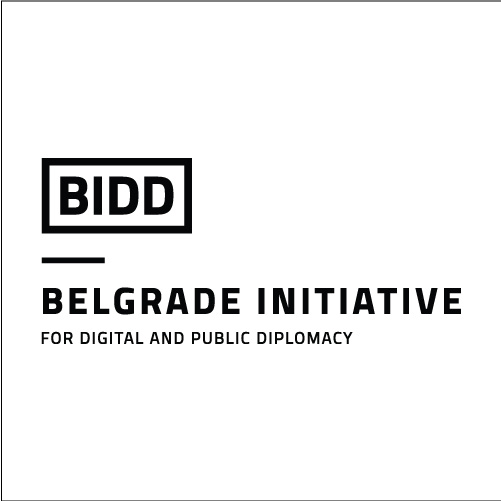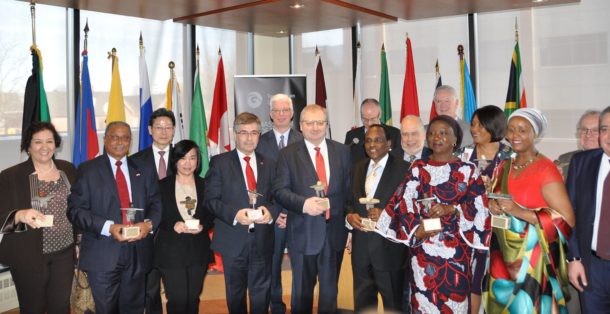Fritz Hahn, The Washington Post, November 29 at 10:00 AM; original article contains links The House of Sweden is a far cry from D.C.’s other fenced, bunkerlike embassies. (Calla Kessler/The Washington Post)
The House of Sweden is a far cry from D.C.’s other fenced, bunkerlike embassies. (Calla Kessler/The Washington Post)
There are close to 200 embassies and diplomatic missions in the District, though most Washingtonians don’t think about them unless they’re driving down Embassy Row or trying to park near a “diplomatic vehicles only” sign. But tell friends or co-workers that you’ve been to lunch at the French Embassy or a tango concert at the Embassy of Argentina, and the questions will pour forth: How do you get an invitation? What’s it like inside? Is it true you’re technically on foreign soil? (The answer to that last question: No.)
The annual E.U. Open House and Passport D.C.’s Around the World Embassy Tour draw long lines for tours, but in many cases, you don’t have to wait until May to experience these international destinations firsthand. Embassies across the District court curious visitors throughout the year with exhibits, concerts, cooking classes and even family story times.
Navigating the world of embassy events can be tricky, however. Some countries, such as Britain, rarely open their doors to the public. Smaller nations can be more outgoing.
For some, public diplomacy [JB emphasis] is the mission. “Haiti often makes the news when something bad happens,” Haitian Ambassador Paul G. Altidor says. “Part of what I’m doing is to offer the Washington community a window into that other side of Haiti they’re not accustomed to seeing” through interactions with Haitian artists, musicians and chefs. “We’re showing aspects of our lives, not just our culture.” And, he adds, if the embassy can shape visitors’ perceptions of Haiti, that vibrant culture might just encourage them to vacation and spend money there.
Sweden’s, which opened on the Georgetown waterfront in 2006, is a far cry from the city’s other fenced, bunkerlike embassies. Last year, says communications counselor Monica Enqvist, it hosted 95 events, including 11 concerts, 17 movie nights and 28 seminars on various topics, in addition to ongoing art exhibits and weekly family days. Over the past 12 years, the House of Sweden has welcomed more than 700,000 visitors. But it’s not just about entertainment: Each year, the staff selects a theme reflecting “Swedish values,” such as migration or gender equality, and shapes its events around the particular topic.
Whether you’re trying to broaden a child’s international outlook or take in art from around the globe, embassies and their cultural centers are an amazing resource. Below is a selection of embassies that open their doors for exhibits, concerts and special events on a monthly or even daily basis. Even better: Most events and exhibitions are free. Each embassy handles events differently — some require RSVPs, some are drop-in — so check the embassy’s website before showing up.
Argentina
Sultry tango music is the soundtrack on New Hampshire Avenue NW, as the Embassy of Argentina draws crowds for free concerts featuring tango orchestras. The annual D.C. Tango Festival, held in the spring, brings milongas, or tango dance parties, as well as lessons for those who want to learn before joining in on the fun. Outside of Argentina’s national dance, the embassy hosts rotating exhibitions in its galleries — a moving series about Holocaust survivors living in Argentina lasts until Dec. 6, followed by abstract works by Argentine artist Alexandra Arata — which are open to the public on weekday afternoons, and offers regular concerts and film series. 1600 New Hampshire Ave. NW. The Austrian Cultural Forum organizes many events, including this concert from the Karklina Trio, at the embassy in Van Ness. (Courtesy of the Austrian Cultural Forum Washington)
The Austrian Cultural Forum organizes many events, including this concert from the Karklina Trio, at the embassy in Van Ness. (Courtesy of the Austrian Cultural Forum Washington)
Austria
The airy auditorium inside the Embassy of Austria in Van Ness is the setting for numerous cultural events, organized by the Austrian Cultural Forum. While it’s best known as an outlet for up-and-coming Austrian classical musicians — a few of whom might perform works by Mozart, Liszt and Schumann — the schedule is far more diverse than you might expect. So far this year, visitors have heard a bilingual poetry slam as part of the Words, Beats and Life hip-hop festival; watched silent films accompanied by live piano music; and listened to experts discuss the viability of a universal basic income. 3524 International Ct. NW.
Canada
The Embassy of Canada occupies a prominent building on Pennsylvania Avenue NW, and although its exterior might not look welcoming, its small art gallery is open to the public on weekdays. Through February, the room is filled with portraits of the “100 greatest” NHL players, a series painted by Canadian artist Tony Harris to celebrate the league’s centennial. (Shockingly, only 83 of them are Canadian.) Previous exhibitions have included works by Inuit artists and photographs of famous Canadians taken by Bryan Adams. (Yes, that Bryan Adams.) 501 Pennsylvania Ave. NW. Chef Mark Courseille prepares lunch at Le Café Descartes in the French Embassy. (Matt McClain/The Washington Post)
Chef Mark Courseille prepares lunch at Le Café Descartes in the French Embassy. (Matt McClain/The Washington Post) An assortment of desserts at Le Café Descartes at the French
An assortment of desserts at Le Café Descartes at the French
The French Embassy hosts a variety of activities in its event space, La Maison Française, in Georgetown. It’s best known for regular, free screenings of French films; other programming includes concerts, wine tastings and, last summer, packed World Cup viewing parties that ended in a champagne-drenched celebration.
Perhaps the most interesting aspect of the embassy, though, is Le Café Descartes, a cafeteria and restaurant open to anyone who fills out a form on its website. The kitchen is run by Mark Courseille, a native of Bordeaux who served as pastry chef at Citronelle and Et Voila! The most popular order, says general manager Max Jacquet, is the three-course, $30 menu du jour, which might include butternut squash soup and sauteed sea scallops. And although fine dining is a draw, don’t overlook the cafeteria, where daily specials, such as duck confit or a haddock filet in sancerre sauce, cost $10. Both are open for lunch daily; the bar hosts Friday happy hours from May through September. 4101 Reservoir Rd. NW.
Haiti
The Embassy of Haiti is regularly open to the public and is one of the most welcoming spots on Embassy Row. Free tours of its art collection are available (reservations are needed only for groups), and on Friday evenings, there’s an open invitation to happy hour: “Come to the embassy and have a rum sour, Haitian-style, on us,” says Paul G. Altidor, who was named ambassador to the United States in 2012. Harder to get into: Manje Lakay, a popular free cooking class with Haitian chefs from around the area. (The lengthy waiting list includes members of Congress, the ambassador boasts.)
One advantage of being a smaller embassy is the personal touch, Altidor says: “If you come to the cooking class, I’m there with you as a student in the class. I could be the one giving you the tour of the embassy and explaining the artwork.” On Dec. 16, Altidor is hosting a holiday market with gifts made by Haitian artisans. 2311 Massachusetts Ave. NW. Twins brothers play with toy blocks in the Room for Children at the House of Sweden. (Calla Kessler/The Washington Post)
Twins brothers play with toy blocks in the Room for Children at the House of Sweden. (Calla Kessler/The Washington Post)
Sweden
The House of Sweden helped redefine embassy events in Washington, booking fashion shows, Eurovision parties, movie nights and Scandinavian indie-rock and hip-hop acts that appealed to a hipster audience instead of the diplomatic community. But that Scandi-cool vibe isn’t the only reason this place is so hot: Its free exhibits and lectures, such as a symposium with American Nobel Prize laureates, challenge visitors to think about larger issues in the world. What the embassy does well is combining the two: On International Women’s Day, for instance, the embassy invited female American and Swedish musicians to talk about gender inequality in the music scene and followed it with a performance from the panelists.
On Saturdays and Sundays, Sweden opens its Room for Children, a space filled with toys, games and books for kids up to 10 years old. (Story time is 2 p.m. Saturday.) The Swedes want to engage children as well as adults, so stories and art workshops become teaching opportunities, explains cultural counselor Monica Enqvist: “The kids love creativity, but we can use it to bring up issues that are important to us all, like climate change.” 2900 K St. NW. The Mexican Cultural Institute on 16th Street NW, just north of Meridian Hill Park. (Evy Mages/For The Washington Post)
The Mexican Cultural Institute on 16th Street NW, just north of Meridian Hill Park. (Evy Mages/For The Washington Post)
Non-embassy embassy events
Some countries take their roles as cultural ambassadors seriously, but for reasons of security or space, don’t open their embassy’s doors to outsiders often. Instead, some, like Spain and Mexico, have turned historical buildings into designated cultural centers, with daily or weekly programming for visitors, as well as movie nights and other special events.
Former residence of the ambassadors of Spain
This beautiful old building on 16th Street NW fell into disrepair after the Spanish ambassador moved out to Foxhall Road, but the airy mansion has been restored and turned into one of the city’s more modern cultural centers. Exhibitions have covered the art of tapas and Spain’s contributions to the Revolutionary War, while the Spanish Embassy’s arts and culture program books a steady stream of concerts, films and dance performances in the space. 2801 16th St. NW.
Goethe-Institut
It often seems like the Goethe-Institut’s primary focus is teaching the German language: The downtown office space offers courses ranging from basic to superintensive, and there are German-only literature classes and conversation groups. But there’s much more available, such as Thursday lunchtime jazz performances, Oktoberfest parties and an English-language book club focused on contemporary German authors. Cinephiles and newcomers alike can enjoy the German Cinema 101 series, which is bringing films from the 1920s to the present to Landmark West End movie house. Most events are free, though the films cost $5 each. 1990 K St. NW.
Japan Information and Culture Center
The Japan Information and Culture Center has become the anime capital of Washington, thanks to its Animezing! series of free screenings. (November featured “Metropolis”; “Cowboy Bebop” is being shown Dec. 12.) The JICC, in a downtown office building, also has an exhibition space; “Folding the Future” looks at how the traditional art of Japanese paper origami could be modified with new materials. In the spring, the JICC hosts a number of events connected to the National Cherry Blossom Festival. 1150 18th St. NW.
Korean Cultural Center
The Korean Cultural Center is located down Embassy Row from the Korean Embassy and Chancery, which puts just the right amount of separation between the two facilities. One is for visas and business meetings; the other organizes a K-pop academy with singing and dance classes. The KCC, as it’s known, underwent a major renovation this year, with a design that takes inspiration from a traditional Korean house. The KCC is open on weekdays for visitors to drop in and peruse the galleries, which change regularly, and the free monthly movie screenings are preceded by an “appetizer social” with snacks. (You have to RSVP, because the free passes can go quickly.) 2370 Massachusetts Ave. NW. The stairs at the Mexican Cultural Institute are lined with a detailed mural showing the history of Mexico. (Calla Kessler/The Washington Post)
The stairs at the Mexican Cultural Institute are lined with a detailed mural showing the history of Mexico. (Calla Kessler/The Washington Post)
Mexican Cultural Institute
From 1921 to 1989, the Embassy of Mexico occupied a landmark Beaux-Arts mansion on 16th Street NW, just north of Meridian Hill Park. When it moved to a building in the West End, it converted its historical home into the Mexican Cultural Institute, preserving the epic and colorful mural painted by Roberto Cueva del Río. The busy calendar of events includes concerts on the first Thursday of the month; movie screenings; seminars with Mexican artists and musicians; and contemporary art exhibitions, which are on display Monday through Saturday. The current “Voice Array,” by Rafael Lozano-Hemmer, is a companion piece to his “Pulse” installation at the Hirshhorn, and is on display until Jan. 31. All of the events are free, except for the cooking classes and dinners taught by James Beard Award-winning chef Pati Jinich, which cost $115 for a series of four and sell out quickly. 2829 16th St. NW.
Original Article
Going Out Guide: Hidden inside Washington’s embassies: a world of fun (and free) stuff to do
Views: 2







